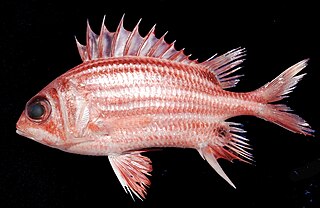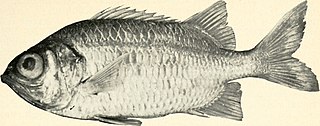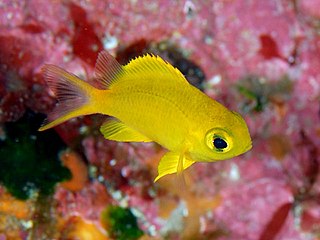
The masked hamlet is a species of marine ray-finned fish, a sea bass from the subfamily Serraninae which is part of the family Serranidae, which also includes the groupers and anthias. This species is found in the western Atlantic Ocean in the Caribbean Sea and has been recorded from the coast of Central America from Quintana Roo in Mexico to Bocas del Toro in Panama and from Jamaica to Puerto Rico, as well as in the Turks and Caicos and the Cayman Islands. Its specific name refers to Providencia Island, Colombia where the type was collected. It was also recorded from other islands in the Archipelago of San Andrés, Providencia and Santa Catalina. They are a unique species in the Hypoplectrus genus, defined by their unique color morph. Their behavior is largely similar to that of other hamlets, especially in their diet and egg-trading spawning patterns.

Chromis chromis, the damselfish or Mediterranean chromis, is a small species of ray-finned fish of the family Pomacentridae from the Eastern Atlantic and Mediterranean.

Pycnochromis margaritifer, known commonly as the bicolor chromis, is a species of marine fish in the family Pomacentridae. The species was reclassified as Pycnochromis margaritifer in 2021, and is still listed under the former name Chromis margaritifer in some places.

Mycteroperca fusca, the Island grouper or comb grouper, is a species of grouper from the family Serranidae which is endemic to the Macaronesian Islands in the eastern Atlantic. It is classified as Vulnerable in The IUCN Red List of Endangered Species.

The Azores chromis or Atlantic chromis is a species of damselfish from the family Pomacentridae which is found in the Macaronesian Islands of the temperate eastern Atlantic Ocean and has been reported from coastal regions of western Africa.

Sargocentron praslin, the dark-striped squirrelfish, is a species of squirrelfish belonging to the genus Sargocentron. It can be found in the Indian Ocean and the West Pacific Ocean, from East Africa south to Mozambique and east to the Marshall Islands excluding the northern Marshall Islands and the Society Islands. It has also been introduced into Libya, Turkey and Cyprus and may also possibly be found in Egypt and Greece. It inhabits reef flats and shallow protected reefs, often in dead reef areas. It is secretive during the day.

Sargocentron suborbitale, the tinsel squirrelfish, is a species of squirrelfish belonging to the genus Sargocentron. It can be found in the East Pacific Ocean from the Gulf of California to Ecuador including the Galapagos Islands. During the day, adults of the species hide in small caves or crevices of rocks. During the night, they feed on small crustaceans in the intertidal zone. It is oviparous.

Myripristis chryseres, the yellowfin soldierfish, is a nocturnal species of soldierfish from the genus Myripristis. It is found in the Indo-Pacific region, from Natal, South Africa to Samoa, Hawaii and the Tuamotu Islands, north to south Japan and the Ogasawara Islands, and south to Queensland, Australia It inhabits steep outer reef slopes and is often seen with Coelacanths at Ngazidja Island. It feeds on zooplankton and can be seen either solitary or in groups.

Myripristis gildi, also known as the Clipperton cardinal soldierfish, is a species of soldierfish belonging to the genus Myripristis. First described in 1965 by Greenfield, it is endemic to Clipperton Island in the Eastern Pacific Ocean. Its total length reaches at least 21.4cm.

Myripristis hexagona, the doubletooth soldierfish, is a nocturnal species of soldierfish from the genus Myripristis. It is light red to yellowish in colour, and grows to a maximum length of 30 cm. It can be found in the Indo-Pacific region, from East Africa to Samoa, north to the Ryukyu Islands, Japan, and south to the Great Barrier Reef and New Caledonia. However, it has not been found on low islands or atolls in the Indo-Pacific region. It is found at depths of 3–40 metres and inhabits sheltered coastal and offshore reefs, typically in turbid areas of bays or lagoons. During the day, it hides in caves or beneath ledges, while at night, it feeds on plankton. It can be found in loose aggregations, sometimes with other species of soldierfish.

Myripristis pralinia, the scarlet soldierfish, is a nocturnal species of soldierfish from the genus Myripristis. It can be found in the Indo-Pacific region, from East Africa to the Marquesas Islands and the Gambier Islands, north to the Ryukyu Islands and south to New Caledonia. It can also be found on the Marshall Islands and the Mariana Islands. It can be found in small, loose groups in caves or under ledges in reef flats, lagoons and outer reef slopes. It feeds on plankton.
Myripristis tiki, the tiki squirrelfish, is a species of soldierfish belonging to the genus Myripristis. It can be found in the Pacific Ocean in the Cook Islands, Tonga, Pitcairn, the Cook Islands and Easter Island.
Myripristis trachyacron, the East Indian soldierfish, is a small, rare, poorly-understood species of soldierfish belonging to the genus Myripristis. It can be found in the Western Pacific Ocean in Indonesia, Philippines, Papua New Guinea and the Solomon Islands. It swims in small aggregations in current prone channels, at moderate slopes. It inhabits outer reef slopes. This species is easily mistaken for Myripristis vittata.
Myripristis woodsi, the whitespot soldierfish, is a species of soldierfish belonging to the genus Myripristis. It is found in the Pacific Ocean, in all of Oceania except Hawaii, the Solomon Islands, New Caledonia, the Caroline Islands, the Line Islands, and north to the Bonin Islands and Marcus Island and south to Samoa and the Tuamoto Islands. It inhabits reef flats, lagoons and seaward reefs. It can be commonly found on exposed outer-reef areas, often at low islands or atolls. It feeds on zooplankton. It is named in honour of ichthyologist Loren Paul Woods.

Chromis agilis, the agile chromis, is a species of damselfish belonging to the genus Chromis. It can be found in the Indian Ocean, from the Maldives, the Chagos Archipelago, Seychelles, Madagascar, the Comoro Islands, and along the East African coastline between Shimoni in Kenya and Bazaruto in Mozambique. It inhabits clear lagoons and seaward reefs, usually in loose aggregations near caves and ledges. It is commonly found over branching corals and leeward coasts. It is oviparous, and the males of the species guard and aerate the eggs.

Chromis albomaculata, the white-spotted chromis, is a diurnal species of damselfish belonging to the genus Chromis. It can be found in the North Western Pacific Ocean in the Izu Islands, Okinawa Island, the Ogasawara Islands and in Taiwan. It inhabits steep slopes and rocky bottoms on offshore reefs. It is oviparous, and the males of the species guard and aerate the eggs.

Chromis chrysura, the stout chromis, is a diurnal species of damselfish belonging to the genus Chromis. Several isolated populations of the species have been found. The first is in Taiwan, the Ryukyu Islands and Southern Japan, the second one lies in the Coral Sea in New Caledonia, Vanuatu, Fiji, and Eastern Australia, and the third one lies in the Western Indian Ocean in Mauritius and Réunion. It is also found in the Philippines and is possibly found in India. It inhabits outer coral or rocky reefs. It usually forms large aggregations in shallow waters and feeds on zooplankton. It is oviparous, and the males of the species guard and aerate the eggs.

Chromis cinerascens, the green puller, is a diurnal species of damselfish belonging to the genus Chromis. It can be found in the Indo-West Pacific region, in Sri Lanka, Maldives, the Andaman Sea, Malaysia, Indonesia, Vietnam, the Philippines, East Timor, Brunei Darussalam, North-western Australia, Hong Kong and Taiwan. It inhabits coral reefs. It is oviparous, and the males of the species guard and aerate the eggs.

Chromis crusma, the valaparaiso chromis, is a species of damselfish belonging to the genus Chromis. It can be found in the South-Eastern Pacific Ocean, from Cabo Blanco, Peru to Talcahuano, Chile. It is oviparous, and the males of the species guard and aerate the eggs.

Chromis albicauda, the white-caudal chromis, is a species of damselfish belonging to the genus Chromis. It can be found in the Western Pacific Ocean along the northern and western shores of Nusa Penida, Indonesia and the southern Japanese seas. It inhabits areas of cool upwelling. It typically forms aggregations, feeding high in the water column on zooplankton when currents are strong. It is oviparous, and the males of the species guard and aerate the eggs.


















